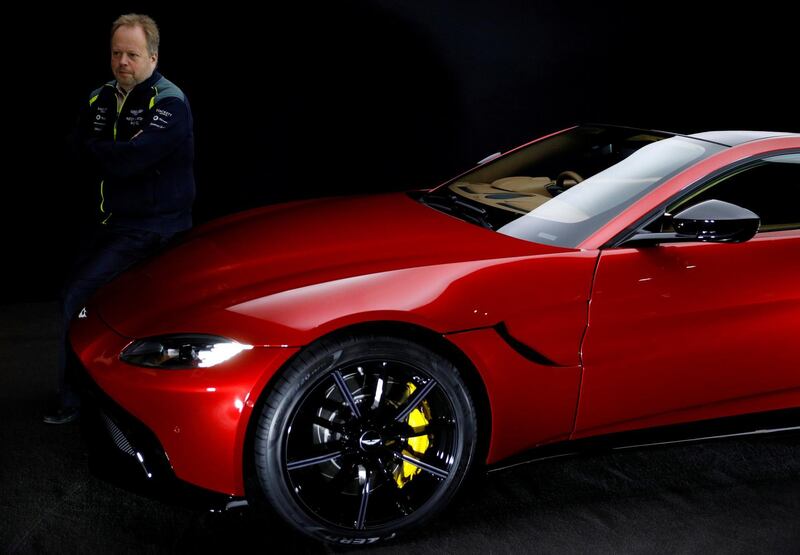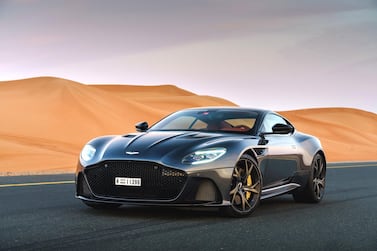Aston Martin officially debuted the electric Rapide E last month at the Shanghai Auto Show - nearly four years after its initial announcement about the car.
Based on the V12-powered Rapide, the saloon will arrive in one small batch, with a scant 155 “special edition” cars produced. But contrary to widespread speculation, it won’t star in the upcoming 25th installment of the James Bond franchise.
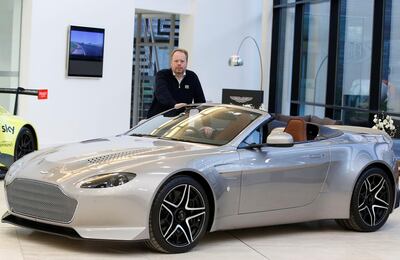
It would have been a somewhat unexpected product placement anyway, considering Bond’s image as a well-dressed rule-breaker, rather than a well-dressed environmentalist. And Great Britain’s 106-year-old company has plenty of bigger problems that even Bond himself wouldn’t be able to fix.
When Deutsche Bank revised its outlook for Aston Martin on April 8 to a more negative view, its shares plummeted, finally settling down by market’s close at half of October’s initial public offering price of £19 (Dh91.41). That figure gave the company a market capitalisation of £4.1 billion. Analysts cited “higher volatility in demand” and “limited share price potential” as factors leading to the downgrade. (The company had announced a $190 million note issue to generate more funds April 3.)
Last year’s IPO fell completely flat, and uncertainty surrounding Brexit and the general cooling of the automotive market has done much to shake investor confidence in the iconic English marque. Aston Martin is currently worth less than one-fifth the value of its rival Ferrari, a company chief executive Andy Palmer had said his brand’s own value would exceed when it made its debut as a public company.
“We’ve taken 105 years to get to an IPO. We’re not going to worry much on what the initial shares are doing,” Mr Palmer said after it went public. “We will always look over the longer term.”
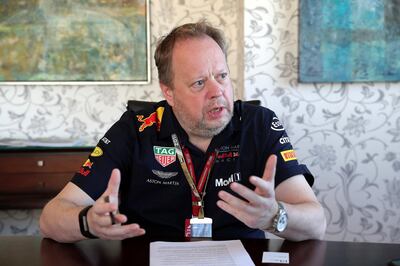
One challenge Aston must face is its historically low production numbers. Last year the brand sold fewer than 6,500 vehicles worldwide, far less than even Porsche, let alone BMW or Mercedes-Benz. That exclusivity has always been part of the brand’s cachet, but to increasingly diminishing returns. In this day and age, when trucks and 4x4s reign supreme, car companies must sell lots of vehicles to stay afloat. Even arch-rival Ferrari has announced plans to make an 4x4.
Meanwhile, Aston Martin has been forced to give deep dealer incentives to jump-start sales of its new Vantage, a $150,000 coupe. The success of that car is crucial to overall corporate health, since as the lower-priced, lower-powered Aston Martin, it was intended to be its biggest seller. And although Aston Martin will report its best Q1 ever for North America this year, the IPO resulted in a pretax loss of £68m for 2018.
“They haven’t had the right product cadence yet,” says Kevin Tynan, the lead automotive analyst for Bloomberg Intelligence. “If anything they’ve been a little quiet while all of this news is happening around them. If you were a conspiracy theorist, you’d be worried about [where they are getting] funding.”
Of course, Mr Tynan notes, quiet doesn’t necessarily mean inactive. If you look carefully, Aston Martin is fighting its demons using the good old-fashioned multi-pronged approach.
Kris Singh is a young investor from Miami who spends millions of dollars at car shows each year buying whatever he wants.
What he wants lately are hybrid supercars.
At the Geneva Motor Show in March, Mr Singh reserved for himself the Aston Martin AM-RB 003, a $2m hybrid that will start production in 2021. The hypercar was among the most-feted debuts at the year’s most exciting show, but it’s far from Aston Martin’s first million-dollar hybrid. The $3m Valkyrie, which runs on a V12 engine paired with a lightweight electric motor, sold out almost instantly when it debuted in 2017, even though it will be later this year before its buyers can take it home.
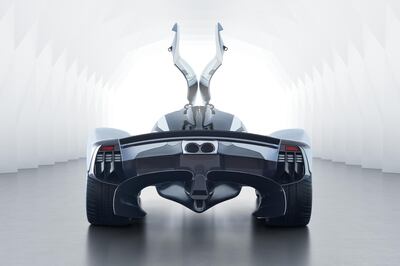
Creating a halo around an electrified supercar is mandatory these days if you want to be like Ferrari. McLaren, Ferrari, Porsche, Pininfarina, and Mercedes-Benz all already make and sell - for very high margins - hybrid or all-electric supercars like the Pininfarina Battista and Ferrari LaFerrari.
Aston Martin declined to comment on the specific margins the company makes on such cars but a spokesperson did note that “specials” like the AM-RB 003 and the Aston Martin Valkyrie have a “significant impact” on the company’s average selling price. In 2018, the average selling price per vehicle at Aston Martin was £141,000 excluding special cars. It was £157,000 including them.
Plus, with a decades-long Formula 1 and endurance racing heritage bolstering the credentials of some of the best-driving sports cars on the market, the car highlights one area where the brand can excel, Mr Tynan says, even if it is in extremely low volumes. The company will make fewer than 500 of them for worldwide distribution.
“Honestly my opinion is that Aston Martin is in a pretty good spot in terms of this whole hypercar and electrification thing,” he says. “People still want their hypercars. They want performance, and they’re willing to pay for it. Aston Martin won’t have to change who they are to fit into the evolution of what’s going on with the industry.”
With their instant torque and less-demanding range demands, it’s no accident that the Valkyrie and AM-RB 003 were Aston Martin’s first major electric-boosted endeavours to get legs. Their intergalactic body styles and high level of customisation provide lightning-rod excitement for the brand, while the technology inside them will trickle down to more affordable wares, all of which will be available in hybrid or pure-electric form by 2025, Mr Palmer said.
Indeed, real-world electric driving performance is where Aston Martin can gain more market foothold. By the end of this year, global sales of electric vehicles will hit 2 million, up from 1.2 million in 2017, according to Frost & Sullivan’s Global Electric Vehicle Market Outlook 2018 report.
Although it’s trotting out the all-electric Rapide E at car shows, the brand is far behind the rest of the pack. Tesla continues to steer the market segment for premium saloons and 4x4s with its waiting-list-only Models S, 3 and X. Porsche will be selling the much-anticipated Taycan saloon by November. Audi and Jaguar are already selling excellent electric 4x4s; BMW and Mercedes-Benz will be selling their own later this year.
What’s more, the race is intensifying. Porsche has said half of its vehicles will be electric by 2023, and BMW says it will do 25 electrified vehicles by 2025. To have a chance of keeping up, Aston Martin must show that it can make reliable daily drivers just as well as it makes track stars - those, ultimately, are where the bread-and-butter profits will derive.
“There are plenty of customers who are high net worth and for whom sustainability is important,” says Ian Fletcher, the principal analyst at IHS Market, an automotive research firm. “Does Aston need to have something more than an electric Rapide E? Of course. But they’re moving forward with their [long-term] strategy, and at the end of the day, they just need to keep pedaling.”
The brand is also aiming to launch a top-tier 4x4 to compete with the Porsche Cayenne and Macan, the Bentley Bentayga, and the Lamborghini Urus. It’s a tactic that’s worked for Bentley, which has doubled production numbers with its new Bentayga, and for Porsche, whose $50,000 Macan is the company’s best-selling vehicle. Scheduled for its official unveiling by the end of 2019, with sales in 2020, the DBX is intended to do the same kind of heavy lifting - Aston wants to double its total production by 2023, Mr Palmer said, when the company will make 14,000 of the vehicles worldwide.
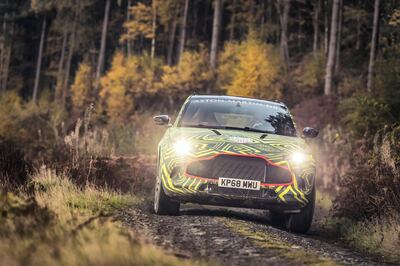
“I think [DBX] bodes well for the brand,” says Stephanie Brinley, a principal automotive analyst for IHS Markit. “Aston Martin is a brand defined by being highly beautiful and highly powerful, but it’s a little less edgy than a Lamborghini, so it naturally fits in that space [of 4x4s and crossovers] to begin with.”
It’s a big step up. In 2018, Aston Martin sold 6,441 vehicles total, up 26 per cent, year over year. It will likely sell 7,300 in 2019, a spokeswoman said. But the hope is that DBX will have a natural home in North America, with its insatiable lust for crossovers and 4x4s. In 2016, 4x4 sales in the US surpassed those of cars. By 2022, Americans will have more new 4x4s from which to choose than cars.
Elsewhere, Aston Martin’s Atlas of an 4x4 must also heave on to its shoulders the responsibility of raising market share in China again after a 31 per cent jump in sales last year. It’s a can’t-miss opportunity to pounce where rivals like Jaguar Land Rover and Daimler have seen sales stumble.
Fortunately for Aston Martin, success in the automotive world is solidified over more time than the first half of this year. “It could be decades before things play out,” Mr Tynan says.
Mr Dean says Aston Martin has enough access to cash in 2019. Mr Fletcher says it has well accounted for contingencies like Brexit and is optimistic in spite of a subtle downturn in global auto markets. “Aston Martin is one of the most bullish despite everything,” he notes.
Unsurprisingly, Mr Palmer himself has recommended taking a long view when evaluating the company’s fortunes.
“We said at the time of the IPO not to buy us if you are not going long term,” he said in February.
"It’s all about growth through 2023.”
